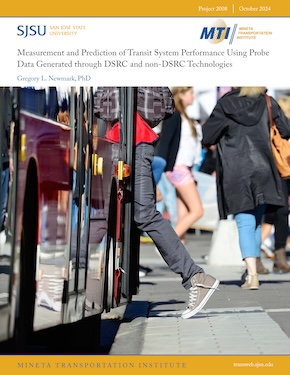- 408-924-7560
- mineta-institute@sjsu.edu
- Donate
Measurement and Prediction of Transit System Performance Using Probe Data Generated through DSRC and non-DSRC Technologies
This research explores the application of two different probe data standards to transit performance measurement. The first section chronicles the proposed and implemented transit uses of dedicated short-range communication (DSRC) technologies during the two decades between the standard’s emergence and its announced sunset. The research finds that, despite proposed applications across safety, operation, and information domains, DSRC never became embedded in transit operations. By contrast, the general transit feed specification (GTFS) standard with its real-time (RT) extension has been widely embraced and offers the potential to use the associated VehiclePosition messages as probe data to generate detailed transit performance metrics. The second section presents a method to decompose transit routes into segments (defined as the path between subsequent stops) and to impute three key time points for each segment: arrival time at the segment start, departure time from the segment start, and arrival time at the segment end. This method is applied to several days of GTFS-RT data from the Modesto Area Express to assess the accuracy of the imputation (in comparison to reported times from the TripUpdate messages) and, in the third and final section, to generate and visualize a series of performance metrics. These metrics assess the deviation between the designed travel times from the GTFS Schedule data and the actual travel times imputed from the GTFS-RT feeds. The research demonstrates an innovative approach to transform probe data generated by GTFS-RT feeds into valuable measures of transit performance at segment-level granularity. The research emphasizes the importance of segment-level transit performance measurement while recognizing that the methods used to impute segment time points are likely to change over time as the GTFS-RT standard evolves.
GREGORY L NEWMARK, PHD
Dr. Newmark is an Associate Professor in the Department of Design and Planning in the School of Architecture and Planning at Morgan State University. He is a research associate of the Mineta Transportation Institute and a faculty researcher at the National Transportation Center. His research focuses on fostering the sustainability of travel, particularly through transit provision and use.
-
Contact Us
San José State University One Washington Square, San Jose, CA 95192 Phone: 408-924-7560 Email: mineta-institute@sjsu.edu






